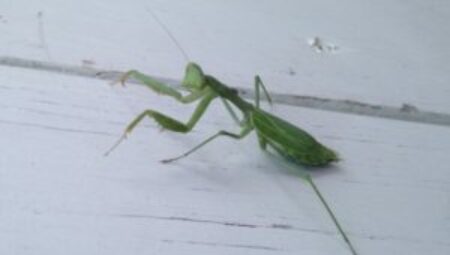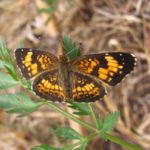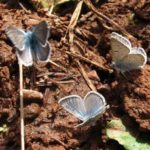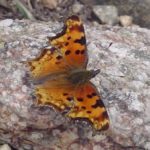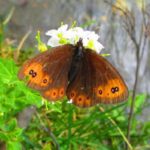Our ‘Spiritual’ Insect Friend, the Praying Mantis
While walking around Hawkins Preserve in Cortez on a recent morning I happened upon an insect that is letting itself be seen more this time of year. I managed to carefully scoop her (or him) up in my hand while she seemed to look at me with curiosity, and took a good look at her perfect little insect body.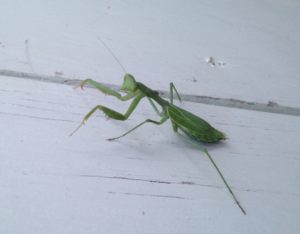
The praying mantis is thus named because of the interesting way it holds its front two legs, looking like they are in a praying position. The word ‘mantis’ actually comes from the Greek ‘mantikos’, meaning prophet. There are over 2,000 species of praying mantids in the world, but only a certain portion of these are actually from the genus ‘mantis’; thus praying ‘mantid’ is usually more correct. Their front legs are used to snag insect prey, and although the mantis may be sold in some garden stores as a beneficial insect, it doesn’t actually discriminate between eating harmful and eating beneficial insects. It will eat a beneficial honeybee just as likely as it will eat a damaging caterpillar.
The praying mantis is also known for its two large compound eyes, adding to its ‘alien-like’ appearance. Less well known, however, are the three simple eyes found between the compound eyes on its triangle-shaped head. The two large eyes enable the mantis to have stereoscopic vision, one of only two insects in the world that have this. The praying mantis is the only insect able to turn its head 180 degrees. Some, but not all, praying mantises have wings. Some praying mantises have one ear, located on their abdomen. It doesn’t hear most sounds very well with this ear, but it is actually able to hear high-pitched bat echolocation ‘peeps’. This enables the mantis to evade bats that are trying to get a midnight snack.
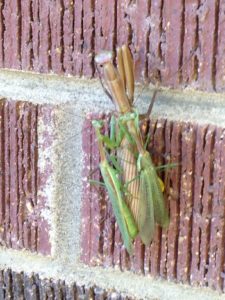 Praying mantises mate in the late summer/early fall, and yes, the rumors are true – the female will sometimes either eat her mate after mating or will even bite his head off in the middle of the act (and the body will finish the job without the head). Although this is much more common in captive mantises than in the wild. Some scientists estimate that wild mantises only cannibalize their mates 25% of the time. Incidentally, since starting to write this article about a week ago, I’ve seen 5 praying mantises in the wild; however, the fourth and fifth ones were a female who at first glance seemed to be holding her mate in her arms lovingly… but in actuality she was enjoying munching on his head! The picture on the left shows a female mantis apparently with 2 mates?!
Praying mantises mate in the late summer/early fall, and yes, the rumors are true – the female will sometimes either eat her mate after mating or will even bite his head off in the middle of the act (and the body will finish the job without the head). Although this is much more common in captive mantises than in the wild. Some scientists estimate that wild mantises only cannibalize their mates 25% of the time. Incidentally, since starting to write this article about a week ago, I’ve seen 5 praying mantises in the wild; however, the fourth and fifth ones were a female who at first glance seemed to be holding her mate in her arms lovingly… but in actuality she was enjoying munching on his head! The picture on the left shows a female mantis apparently with 2 mates?!
A female praying mantis found in the fall may be looking for a location to lay her egg cases called oothecae. She will lay perhaps hundreds of eggs in each ootheca, which initially looks rather soft and foamy, but eventually dries up, looking more like brown styrofoam. The young stay and grow in this case until spring or early summer when they all hatch out at once! The young nymphs that hatch look just like smaller versions of the adults. As the nymphs grow, they will periodically shed their exoskeleton, having a softer exoskeleton that forms underneath, and eventually hardens. They will do this 6 – 9 times before becoming an adult size.
Despite being predators in the insect world, praying mantises are also preyed upon. Spiders, ants, frogs, lizards, and birds are all predators of the praying mantis. Their main defense is camouflage, and some blend in very well – mimicking flowers, leaves, and sticks in their habitat.
Seeing a praying mantis can be considered to be good luck or bad, depending on your culture. Because of the ‘praying’ hands, some Christians say that the praying mantis represents spiritualism or piety, and if found in your home, may mean that angels are watching over you. Some Muslims say that the praying mantis is always facing towards Mecca. However, in Italy, some believe that if a praying mantis looks at you menacingly, it can make you sick, and in Japan, it may even be a foretelling of your death. Personally, I feel lucky any time I get to see one of these amazing insects, and can’t wait to see more.
Butterflies and Mountain Wildflowers
Butterflies and Mountain Wildflowers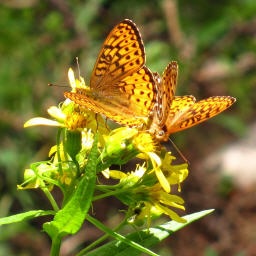
The summer rains have arrived. Yippee! These rains are helpful in so many ways. Perhaps mostly noticeably they provide enough water for the mountain wildflowers to bloom. These flowers coat the hillsides is a glorious canvas of color. The flowers also produce delicious nectar that is enjoyed by many of nature’s creatures. Look carefully and you will see hummingbirds, ants, bees, flies and others feeding on the nectar. When the sun is shining, butterflies are often seen drinking from these fantastic flowers.
What is a Butterfly?
Butterflies are a member of the insect family, and together with moths makeup the order known as ‘Lepidoptera’. The dividing line between butterflies and moths is fairly fuzzy and some creatures could seem to fall into either category. However, the main difference between them is butterflies are generally active in the day and moths are active at night. Also, in a resting position, moths lay their wings down over their bodies, while butterflies stand their wings up so that their undersides may be seen.
Fairly large colorful wings grace the butterfly and give the ability to fly. The large number of yellow winged varieties is probably responsible for the name. The wings seem uniquely designed to help avoid predators, but at the same time to attract mates. Eye patterns in some wings will ward off discerning birds and colorful displays sometimes serve as a warning of bitter flavors to keep away the epicureans. Meanwhile these patterns are recognized by other butterflies of the same species as a call to mate.
Butterflies have a large proboscis, which is actually a mouthpart, and is used to suck nectar and fluids from flowers. While feeding themselves butterflies also serve the function of helping to pollinate flowers.Adult females lay the eggs on a leaf that will become a food source for the new caterpillars. The caterpillars grow bigger and bigger as they eat the leaves. Eventually something is triggered in the caterpillar and it finds aquiet spot to go into its chrysalis phase. The caterpillar does not “build” a chrysalis around itself. Instead, the caterpillar sheds its skin and the chrysalis is underneath.
Their antennae are generally “clubbed” and covered with tiny hairs that also may be found on much of the rest of the body. These hairs tell the butterfly about wind currents, water, vibrations and nearby objects. Butterflies have two compound eyes that see a broad spectrum of light including ultraviolet.
The time lines for (adult) butterflies vary widely, from a few weeks to a couple of years. Some, such as the monarch butterfly actually migrate for various stages and activities. Butterflies also vary widely in size, color and activity.
A butterfly has four stages in its life cycle: egg, larva (caterpillar), pupa (chrysalis) and adult (butterfly). It is a repetitive cycle, but the butterfly does not turn back into an egg!
Like most animals, the male and female adults work together to produce new fertilized eggs.
Adult females lay the eggs on a leaf that will become a food source for the new caterpillars. The caterpillars grow bigger and bigger as they eat the leaves. Eventually something is triggered in the caterpillar and it finds a quiet spot to go into its chrysalis phase. The caterpillar does not “build” a chrysalis around itself. Instead, the caterpillar sheds its skin and the chrysalis is underneath. When the butterfly emerges from its chrysalis, its new wings are fragile. It waits patiently for the wings to dry out and strengthen. Then it flutters away! Many other insects go through similar life cycles.
Colorado Mountain Butterflies and Flowers
There are over 60 species of butterflies in Colorado. Here are some of the more common ones seen in the summer above 8,500 feet and the flowers on which they feed. They vary greatly in size, color and plant food. Read on to learn more about these winged wonders!
Callippe Fritillary – 2 1/8”
Easier to spot than it is to spell, this butterfly is everywhere from June to August. Their colors fade as they reach the end of their lives.
Favorite flowers: milkweeds, thistles, dogbane, vetch,red clover, cow parsnip
Appropriately named, this butterfly is identified by thespots within its checkered pattern. There are at least 8 species of checkerspots in Colorado and pattern varies within each species.
Favorite flowers: asters, paintbrushes
Western Tiger Swallowtail – 3 1/2”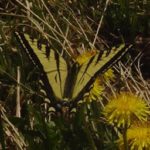
One of the largest butterflies you will see, these are also some of the most common butterflies during June and July.
Favorite flowers: many flowers, including red clover,dandelion and thistles
These little beauties are so small, you might miss them…until you startle them and they flutter away. Look for them in muddy, wet areas. They love moisture.Arrowhead blues are one of many species of blues in Colorado. It is differentiated by a tiny orange arrowhead on the outside bottom of each hind wing.
Favorite flowers: anything in the pea family, especially lupines
Easily mistaken for the larger Tortoiseshell, the Comma has a small comma in the center underside of its hind wing. This butterfly hibernates in winter.
Favorite flowers: varies, includes currants
This butterfly is not as common in this area as the name would imply. Look carefully and you may be fortunate enough to spot one.
Favorite flowers: grasses, cow parsnip, bittercress
All photos copyright MK Gunn 2007 – 2012 unless otherwise noted.
Save the Date!
Want to learn more about butterflies and flowers? MK Gunn is leading a Butterflies and Blooms hike up Cascade Creek on Saturday, July 30th, 9:30am – noon. Details can be found here.

